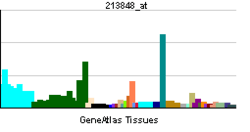DUSP7
| DUSP7 | |||||||||||||||
|---|---|---|---|---|---|---|---|---|---|---|---|---|---|---|---|
| |||||||||||||||
| Identifiers | |||||||||||||||
| Aliases | DUSP7, MKPX, PYST2, dual specificity phosphatase 7 | ||||||||||||||
| External IDs | MGI: 2387100 HomoloGene: 1468 GeneCards: DUSP7 | ||||||||||||||
| RNA expression pattern | |||||||||||||||
  | |||||||||||||||
| More reference expression data | |||||||||||||||
| Orthologs | |||||||||||||||
| Species | Human | Mouse | |||||||||||||
| Entrez | |||||||||||||||
| Ensembl | |||||||||||||||
| UniProt | |||||||||||||||
| RefSeq (mRNA) | |||||||||||||||
| RefSeq (protein) | |||||||||||||||
| Location (UCSC) | Chr 3: 52.05 – 52.06 Mb | Chr 9: 106.37 – 106.38 Mb | |||||||||||||
| PubMed search | [1] | [2] | |||||||||||||
| Wikidata | |||||||||||||||
| View/Edit Human | View/Edit Mouse |
Dual specificity protein phosphatase 7 is an enzyme that in humans is encoded by the DUSP7 gene.[3][4][5]
Function
Dual-specificity phosphatases (DUSPs) constitute a large heterogeneous subgroup of the type I cysteine-based protein-tyrosine phosphatase superfamily. DUSPs are characterized by their ability to de-phosphorylate both tyrosine (EC 3.1.3.48) and serine / threonine (EC 3.1.3.16) residues. DUSP7 belongs to a class of DUSPs, designated MKPs, that dephosphorylate MAPK (mitogen-activated protein kinase) proteins ERK, JNK, and p38 with specificity distinct from that of individual MKP proteins. MKPs contain a highly conserved C-terminal catalytic domain and an N-terminal Cdc25-like (CH2) domain. MAPK activation cascades mediate various physiologic processes, including cellular proliferation, apoptosis, differentiation, and stress responses.[5][6]
It is known to bind and dephosphorylate ErkII, and as it, along with the other members of the DUSP family expresses high selectively for MAP kinases, it has been suggested that it functions as a method for selectively activating/deactivating different members of that family.[7]
References
- ↑ "Human PubMed Reference:".
- ↑ "Mouse PubMed Reference:".
- ↑ Muda M, Boschert U, Dickinson R, Martinou JC, Martinou I, Camps M, Schlegel W, Arkinstall S (Jun 1996). "MKP-3, a novel cytosolic protein-tyrosine phosphatase that exemplifies a new class of mitogen-activated protein kinase phosphatase". J Biol Chem. 271 (8): 4319–26. doi:10.1074/jbc.271.8.4319. PMID 8626780.
- ↑ Smith A, Price C, Cullen M, Muda M, King A, Ozanne B, Arkinstall S, Ashworth A (Sep 1997). "Chromosomal localization of three human dual specificity phosphatase genes (DUSP4, DUSP6, and DUSP7)". Genomics. 42 (3): 524–7. doi:10.1006/geno.1997.4756. PMID 9205128.
- 1 2 "Entrez Gene: DUSP7 dual specificity phosphatase 7".
- ↑ Patterson KI, Brummer T, O'Brien PM, Daly RJ (March 2009). "Dual-specificity phosphatases: critical regulators with diverse cellular targets". Biochem. J. 418 (3): 475–89. PMID 19228121.
- ↑ Dowd S, Sneddon AA, Keyse SM (November 1998). "Isolation of the human genes encoding the pyst1 and Pyst2 phosphatases: characterisation of Pyst2 as a cytosolic dual-specificity MAP kinase phosphatase and its catalytic activation by both MAP and SAP kinases". J. Cell. Sci. 111 (22): 3389–99. PMID 9788880.
Further reading
- Groom LA, Sneddon AA, Alessi DR, et al. (1996). "Differential regulation of the MAP, SAP and RK/p38 kinases by Pyst1, a novel cytosolic dual-specificity phosphatase". EMBO J. 15 (14): 3621–32. PMC 451978
 . PMID 8670865.
. PMID 8670865. - Dowd S, Sneddon AA, Keyse SM (1999). "Isolation of the human genes encoding the pyst1 and Pyst2 phosphatases: characterisation of Pyst2 as a cytosolic dual-specificity MAP kinase phosphatase and its catalytic activation by both MAP and SAP kinases". J. Cell. Sci. 111 (22): 3389–99. PMID 9788880.
- Strausberg RL, Feingold EA, Grouse LH, et al. (2003). "Generation and initial analysis of more than 15,000 full-length human and mouse cDNA sequences". Proc. Natl. Acad. Sci. U.S.A. 99 (26): 16899–903. doi:10.1073/pnas.242603899. PMC 139241
 . PMID 12477932.
. PMID 12477932. - Pasquali C, Curchod ML, Wälchli S, et al. (2004). "Identification of protein tyrosine phosphatases with specificity for the ligand-activated growth hormone receptor". Mol. Endocrinol. 17 (11): 2228–39. doi:10.1210/me.2003-0011. PMID 12907755.
- Levy-Nissenbaum O, Sagi-Assif O, Kapon D, et al. (2003). "Dual-specificity phosphatase Pyst2-L is constitutively highly expressed in myeloid leukemia and other malignant cells". Oncogene. 22 (48): 7649–60. doi:10.1038/sj.onc.1206971. PMID 14576828.
- Levy-Nissenbaum O, Sagi-Assif O, Witz IP (2004). "Characterization of the dual-specificity phosphatase PYST2 and its transcripts". Genes Chromosomes Cancer. 39 (1): 37–47. doi:10.1002/gcc.10295. PMID 14603440.
- Levy-Nissenbaum O, Sagi-Assif O, Raanani P, et al. (2004). "cDNA microarray analysis reveals an overexpression of the dual-specificity MAPK phosphatase PYST2 in acute leukemia". Meth. Enzymol. Methods in Enzymology. 366: 103–13. doi:10.1016/S0076-6879(03)66009-X. ISBN 978-0-12-182269-9. PMID 14674243.
- Orlev LN, Ehud B, Tamar BG, et al. (2004). "Does the dual-specificity MAPK phosphatase Pyst2-L lead a monogamous relationship with the Erk2 protein?". Immunol. Lett. 92 (1–2): 149–56. doi:10.1016/j.imlet.2003.11.024. PMID 15081539.
- Gerhard DS, Wagner L, Feingold EA, et al. (2004). "The Status, Quality, and Expansion of the NIH Full-Length cDNA Project: The Mammalian Gene Collection (MGC)". Genome Res. 14 (10B): 2121–7. doi:10.1101/gr.2596504. PMC 528928
 . PMID 15489334.
. PMID 15489334.
This article incorporates text from the United States National Library of Medicine, which is in the public domain.